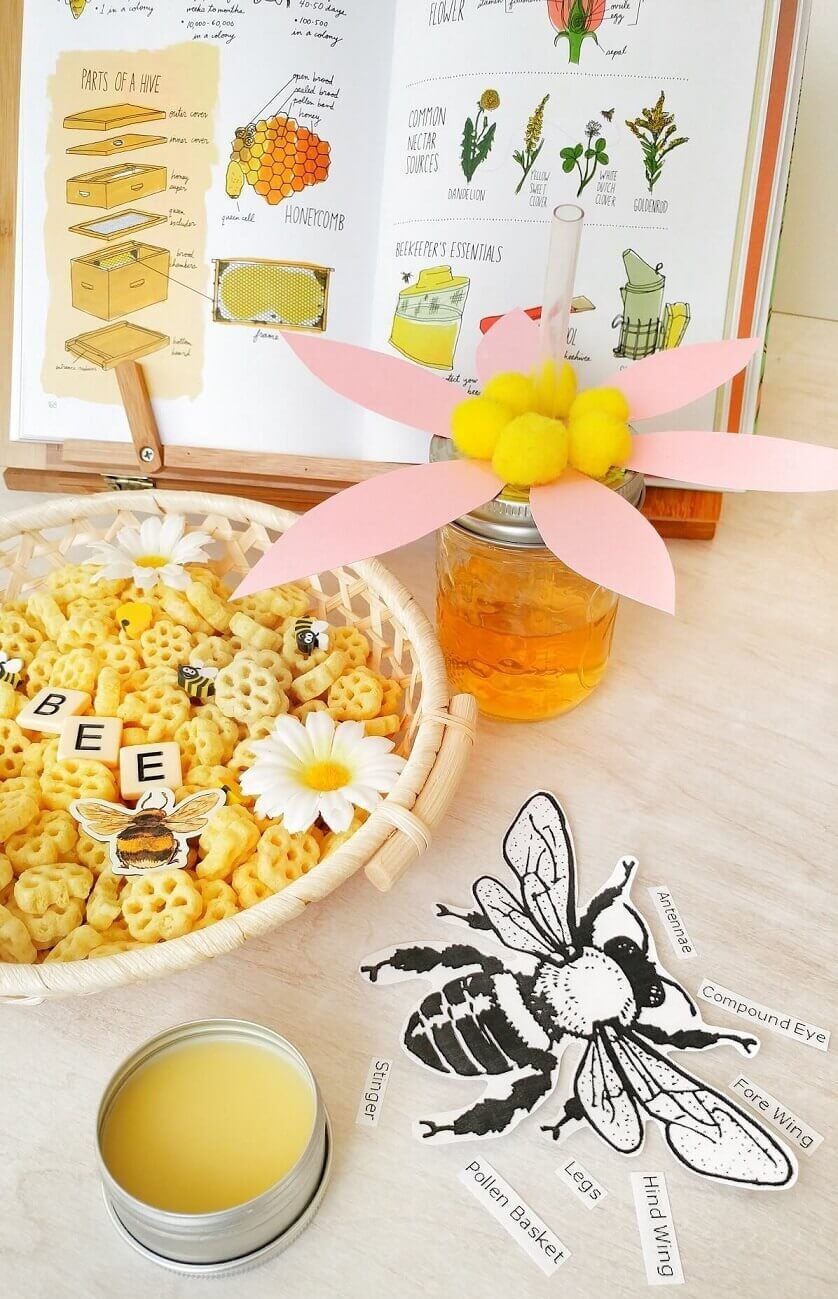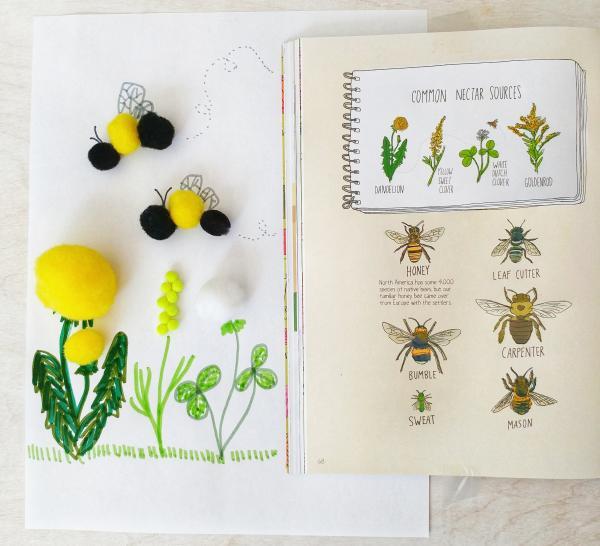
A Closer Look at Bees
In following The Playful Pioneers curriculum this week, we were led to study bees, beeswax and their common nectar sources. This study inspired the below activities and then so much more…we “followed the spark” and down the rabbit-hole we went for a fun-filled week studying all things bees!

We used both Nature Anatomy and Farm Anatomy by Julia Rothman to kick off our study and repeatedly, throughout our week as reference. After recreating bees and their common nectar sources with pom poms and markers, we moved on to study their anatomy.

We used THESE beautiful, free printables by The Homeschool Scientist to discover and label the parts of a bee and also, how to identify worker, drone and queen bees.
I love using a black felt mat to present these materials, it makes the illustration pop, keeps the parts all in one place ![]() and gives focus to our study.
and gives focus to our study.
The girls were so intrigued by the bees’ pollen baskets that it was only natural to move on to a closer look at pollen and nectar.

We made little bumbles with pompoms, craft foam and pipe cleaners.
Bee Pom Poms by CalCastle

![]()
We then made a beautiful food source for them…a mason jar filled with apple juice “nectar” and topped with a colourful flower, complete with pompoms covered in glitter “pollen”.
The girls had bumble bee wings they adorned and buzzed in for a sip of nectar and to let their bumbles pick up some of the glittery pollen.
Bee Costume by Cutie Collections
![]()

We read this sweet yet fact-filled story of the importance of bees in our natural world. This book really hit home for the girls and they both were struck with the thought of what the world would be like without bees.
“No Honey!” said Miss 4…”no fruit…no veggies…no flowers??” said Miss 7.
Big City Bees by Maggie de Vries
We read a mountain of bee themed books this week and I will share my favourites as we go…but these two were gold stars in my opinion!
The Life and Times of the Honeybee by Charles Micucci
![]() Bees: A Honeyed History by Piotr Socha
Bees: A Honeyed History by Piotr Socha
![]()

We learned that in addition to pollen and nectar, field bees also gather water from puddles and sap from plant buds. What do they use all these materials for? “The Life and Times of the Honeybee” by Charles Micucci explains it beautifully but basically, it is all for the benefit of the hive.
We decided to make a fun little beehive of our very own using a styrofoam ball, honey comb shaped cereal, yellow paint and a stick. We discussed how actual hives are made and the difference between wild bees and farm raised bees. We love our little hive!
 While exploring the hive we learned that bees work so hard to care for the next generation of bees, so we next delved into the life-cycle of a bee!
While exploring the hive we learned that bees work so hard to care for the next generation of bees, so we next delved into the life-cycle of a bee!
We used THESE gorgeous, free printables by Montessori Soul…they paired so nicely with our bee life cycle set!
Bee Life Cycle by Safari Ltd

We took the time to read more books and enjoyed a few videos online at this point.
The Honey Makers by Gail Gibbons
The Honeybee Man by Lela Nargi
This one was definitely a top contender for Top Bee Book! We all loved it!

![]()
Flight of the Honey Bee by Raymond Huber
While we read, we kept little hands busy with a bee themed mini-playdough kit.
Honeycomb shaped cereal, googly eyes, yellow jewels, silver jewels, black pipe cleaner and yellow play dough. ![]() I laid out our Farm Anatomy by Julia Rothman for inspiration…queen bee, worker bee or drone bee…what would two little girls choose to do?? QUEEN BEE all the way!
I laid out our Farm Anatomy by Julia Rothman for inspiration…queen bee, worker bee or drone bee…what would two little girls choose to do?? QUEEN BEE all the way!


We next talked about all the wonderful things bees provide for us and how they are used.
In our home, we use beeswax when making salve for colds, aches and pains and insomnia or for candle making.
We decided we would make a new batch of salve using beeswax and lavender, we followed the recipe provided with The Playful Pioneer curriculum cook book…HERE is one by A Delightful Home that is very similar.
Beeswax Pellets by Beesworks 
![]()

We also enjoyed hexagon shaped crackers and local honey (which, by the way,has helped us all immensely in battling allergies last season!) as our snack for the day.
Honey Dipper Lid by Jarware 

We also incorporated our theme into our math studies for the week…
These Bees Count by Alison Formento
Geo-board bees…

Counting fun with the help of The Sylvan Reverie’s gorgeous printables HERE…

and a fun game…

Build a tower of honeycombs for the bee by taking turns rolling the dice and stacking up the matching number of honeycombs. The tallest tower after 5 rounds wins!
What a fun week! What are your favorite bee books and activities?
Sue
“We are a participant in the Amazon Services LLC Associates Program,
an affiliate advertising program designed to provide a means for us to
earn fees by linking to Amazon.com and affiliated sites.”
![]()



4 Comments
richardsonfamily
This is great! We just decided to use Playful Pioneers for the upcoming school year to supplement our curriculum. So, this is a general question…what did you find was the best way to organize the printed material? Did you spiral bind the parent guide, teacher guide, etc separately? Or did you just print it out and organize all into a three ring binder? Just curious to know what worked for you! Thanks…your posts are inspiring!
Naomi
i am so moved by all your inspirational posts. I love your approach to homeschooling and your style . I picture you getting many awards and being featured on all the top sites, magazines and television shows.
Nichole
Wow! Lots covered 🙂 thanks for sharing all your ideas and book suggestions.